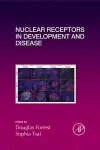
Nuclear Receptors in Development and Disease PDF
Preview Nuclear Receptors in Development and Disease
CURRENT TOPICS IN DEVELOPMENTAL BIOLOGY “Ameeting-groundforcriticalreviewanddiscussionofdevelopmentalprocesses” A.A.MosconaandAlbertoMonroy(Volume1,1966) SERIES EDITOR Paul M. Wassarman Department ofDevelopmental andRegenerative Biology IcahnSchool ofMedicine atMount Sinai New York, NY,USA CURRENT ADVISORY BOARD Blanche Capel Susan Mango Wolfgang Driever Philippe Soriano Denis Duboule Cliff Tabin Anne Ephrussi MagdalenaZernicka-Goetz FOUNDING EDITORS A.A. Moscona and Alberto Monroy FOUNDING ADVISORY BOARD Vincent G. Allfrey Dame Honor B.Fell Jean Brachet John C. Kendrew Seymour S. Cohen S.Spiegelman Bernard D.Davis Hewson W.Swift James D. Ebert E.N.Willmer Mac V. Edds, Jr. Etienne Wolff AcademicPressisanimprintofElsevier 50HampshireStreet,5thFloor,Cambridge,MA02139,UnitedStates 525BStreet,Suite1800,SanDiego,CA92101-4495,UnitedStates TheBoulevard,LangfordLane,Kidlington,OxfordOX51GB,UnitedKingdom 125LondonWall,London,EC2Y5AS,UnitedKingdom Firstedition2017 Copyright©2017ElsevierInc.Allrightsreserved. Nopartofthispublicationmaybereproducedortransmittedinanyformorbyanymeans, electronicormechanical,includingphotocopying,recording,oranyinformationstorageand retrievalsystem,withoutpermissioninwritingfromthepublisher.Detailsonhowtoseek permission,furtherinformationaboutthePublisher’spermissionspoliciesandour arrangementswithorganizationssuchastheCopyrightClearanceCenterandtheCopyright LicensingAgency,canbefoundatourwebsite:www.elsevier.com/permissions. Thisbookandtheindividualcontributionscontainedinitareprotectedundercopyrightby thePublisher(otherthanasmaybenotedherein). Notices Knowledgeandbestpracticeinthisfieldareconstantlychanging.Asnewresearchand experiencebroadenourunderstanding,changesinresearchmethods,professionalpractices, ormedicaltreatmentmaybecomenecessary. Practitionersandresearchersmustalwaysrelyontheirownexperienceandknowledgein evaluatingandusinganyinformation,methods,compounds,orexperimentsdescribed herein.Inusingsuchinformationormethodstheyshouldbemindfuloftheirownsafetyand thesafetyofothers,includingpartiesforwhomtheyhaveaprofessionalresponsibility. Tothefullestextentofthelaw,neitherthePublishernortheauthors,contributors,oreditors, assumeanyliabilityforanyinjuryand/ordamagetopersonsorpropertyasamatterof productsliability,negligenceorotherwise,orfromanyuseoroperationofanymethods, products,instructions,orideascontainedinthematerialherein. ISBN:978-0-12-802172-9 ISSN:0070-2153 ForinformationonallAcademicPresspublications visitourwebsiteathttps://www.elsevier.com/books-and-journals Publisher:ZoeKruze AcquisitionEditor:ZoeKruze EditorialProjectManager:ShellieBryant ProductionProjectManager:VigneshTamil CoverDesigner:GregHarris TypesetbySPiGlobal,India CONTRIBUTORS MichihikoAramaki LaboratoryofEndocrinologyandReceptorBiology,NIDDK,NationalInstitutesofHealth, Bethesda,MD,UnitedStates YukitomoArao ReproductiveandDevelopmentalBiologyLaboratory,NationalInstituteofEnvironmental HealthSciences/NIH,ResearchTrianglePark,NC,UnitedStates JonathanT.Busada MolecularEndocrinologyGroup,SignalTransductionLaboratory,NationalInstituteof EnvironmentalHealthSciences,NationalInstitutesofHealth,ResearchTrianglePark,NC, UnitedStates ChawnshangChang GeorgeWhippleLabforCancerResearch,TheWilmotCancerCenter,Universityof RochesterMedicalCenter,Rochester,NY,UnitedStates;SexHormoneResearchCenter, ChinaMedicalUniversity/Hospital,Taichung,Taiwan Hong-ChiangChang GeorgeWhippleLabforCancerResearch,TheWilmotCancerCenter,Universityof RochesterMedicalCenter,Rochester,NY,UnitedStates KrishnaChatterjee Wellcome-MRCInstituteofMetabolicScience,UniversityofCambridge,Cambridge, UnitedKingdom AlysM.CheatleJarvela UniversityofMaryland,CollegePark,MD,UnitedStates JohnA.Cidlowski MolecularEndocrinologyGroup,SignalTransductionLaboratory,NationalInstituteof EnvironmentalHealthSciences,NationalInstitutesofHealth,ResearchTrianglePark,NC, UnitedStates QiCui BeckmanResearchInstituteofCityofHope;Irell&ManellaGraduateSchoolofBiological Sciences,BeckmanResearchInstituteofCityofHope,Duarte,CA,UnitedStates FrancescoJ.DeMayo ReproductiveandDevelopmentalBiologyLaboratory,NationalInstituteofEnvironmental HealthSciences,NationalInstituteofHealth,ResearchTrianglePark,NC,UnitedStates SuFeng InstituteofLifeScience,NanchangUniversity,Nanchang,Jiangxi,China xi xii Contributors Fr(cid:1)ed(cid:1)ericFlamant InstitutdeG(cid:1)enomiqueFonctionnelledeLyon,Universit(cid:1)edeLyon,Universit(cid:1)eLyon1, CNRSUMR5242,INRAUSC1370,EcoleNormaleSup(cid:1)erieuredeLyon,Lyoncedex, France DouglasForrest LaboratoryofEndocrinologyandReceptorBiology,NIDDK,NationalInstitutesofHealth, Bethesda,MD,UnitedStates YulongFu LaboratoryofEndocrinologyandReceptorBiology,NIDDK,NationalInstitutesofHealth, Bethesda,MD,UnitedStates KarineGauthier InstitutdeG(cid:1)enomiqueFonctionnelledeLyon,Universit(cid:1)edeLyon,Universit(cid:1)eLyon1, CNRSUMR5242,INRAUSC1370,EcoleNormaleSup(cid:1)erieuredeLyon,Lyoncedex, France NorbertB.Ghyselinck InstitutdeG(cid:1)en(cid:1)etiqueetdeBiologieMol(cid:1)eculaireetCellulaire(IGBMC),Illkirch;Centre NationaldelaRechercheScientifique(CNRS);InstitutNationaldelaSant(cid:1)eetdela RechercheM(cid:1)edicale(INSERM),Paris;Universit(cid:1)edeStrasbourg(UNISTRA),Strasbourg, France KatherineJ.Hamilton ReproductiveandDevelopmentalBiologyLaboratory,NationalInstituteofEnvironmental HealthSciences/NIH,ResearchTrianglePark,NC,UnitedStates SylviaC.Hewitt ReproductiveandDevelopmentalBiologyLaboratory,NationalInstituteofEnvironmental HealthSciences/NIH,ResearchTrianglePark,NC,UnitedStates GuillaumeHolzer InstitutdeG(cid:1)enomiqueFonctionnelledeLyon,Universit(cid:1)edeLyon,Universit(cid:1)eLyon1, CNRS,EcoleNormaleSup(cid:1)erieuredeLyon,LyonCedex07,France KennethS.Korach ReproductiveandDevelopmentalBiologyLaboratory,NationalInstituteofEnvironmental HealthSciences/NIH,ResearchTrianglePark,NC,UnitedStates VincentLaudet ObservatoireOc(cid:1)eanologiquedeBanyuls-sur-Mer,UMR7232,Universit(cid:1)ePierreetMarie Curie,Paris,Banyuls-sur-Mer,France GonghuiLi GeorgeWhippleLabforCancerResearch,TheWilmotCancerCenter,Universityof RochesterMedicalCenter,Rochester,NY,UnitedStates;SirRunRunShawHospital, ZhejiangUniversity,Hangzhou,China Chang-YiLin GeorgeWhippleLabforCancerResearch,TheWilmotCancerCenter,Universityof RochesterMedicalCenter,Rochester,NY,UnitedStates Contributors xiii Shin-JenLin GeorgeWhippleLabforCancerResearch,TheWilmotCancerCenter,Universityof RochesterMedicalCenter,Rochester,NY,UnitedStates HongLiu LaboratoryofEndocrinologyandReceptorBiology,NIDDK,NationalInstitutesofHealth, Bethesda,MD,UnitedStates ManuelMark InstitutdeG(cid:1)en(cid:1)etiqueetdeBiologieMol(cid:1)eculaireetCellulaire(IGBMC),Illkirch;Centre NationaldelaRechercheScientifique(CNRS);InstitutNationaldelaSant(cid:1)eetdela RechercheM(cid:1)edicale(INSERM),Paris;Universit(cid:1)edeStrasbourg(UNISTRA);Ho^pitaux UniversitairesdeStrasbourg(HUS),Strasbourg,France GabrielV.Markov SorbonneUniversit(cid:1)es,UPMCUniversit(cid:1)eParis06,CNRS,UMR8227,IntegrativeBiology ofMarineModels,StationBiologiquedeRoscoff,PlaceGeorgesTeissier,RoscoffCedex, France MarcelE.Meima ErasmusUniversityMedicalCenter,Rotterdam,TheNetherlands CarlaMoran Wellcome-MRCInstituteofMetabolicScience,UniversityofCambridge,Cambridge, UnitedKingdom RobinP.Peeters ErasmusUniversityMedicalCenter,Rotterdam,TheNetherlands LesliePick UniversityofMaryland,CollegePark,MD,UnitedStates SabineRichard InstitutdeG(cid:1)enomiqueFonctionnelledeLyon,Universit(cid:1)edeLyon,Universit(cid:1)eLyon1, CNRSUMR5242,INRAUSC1370,EcoleNormaleSup(cid:1)erieuredeLyon,Lyoncedex, France YanhongShi BeckmanResearchInstituteofCityofHope;Irell&ManellaGraduateSchoolofBiological Sciences,BeckmanResearchInstituteofCityofHope,Duarte,CA,UnitedStates GuoqiangSun BeckmanResearchInstituteofCityofHope,Duarte,CA,UnitedStates KeTang InstituteofLifeScience,NanchangUniversity,Nanchang,Jiangxi,China MariusTeletin InstitutdeG(cid:1)en(cid:1)etiqueetdeBiologieMol(cid:1)eculaireetCellulaire(IGBMC),Illkirch;Centre NationaldelaRechercheScientifique(CNRS);InstitutNationaldelaSant(cid:1)eetdela RechercheM(cid:1)edicale(INSERM),Paris;Universit(cid:1)edeStrasbourg(UNISTRA);Ho^pitaux UniversitairesdeStrasbourg(HUS),Strasbourg,France xiv Contributors Ming-JerTsai BaylorCollegeofMedicine;PrograminDevelopmentalBiology,BaylorCollegeof Medicine,Houston,TX,UnitedStates SophiaTsai BaylorCollegeofMedicine;DepartmentofMolecularandCellularBiology,Programin DevelopmentalBiology,BaylorCollegeofMedicine,Houston,TX,UnitedStates AnjaL.M.vanGucht ErasmusUniversityMedicalCenter,Rotterdam,TheNetherlands Nade`geVernet InstitutdeG(cid:1)en(cid:1)etiqueetdeBiologieMol(cid:1)eculaireetCellulaire(IGBMC),Illkirch;Centre NationaldelaRechercheScientifique(CNRS);InstitutNationaldelaSant(cid:1)eetdela RechercheM(cid:1)edicale(INSERM),Paris;Universit(cid:1)edeStrasbourg(UNISTRA),Strasbourg, France TheoJ.Visser ErasmusUniversityMedicalCenter,Rotterdam,TheNetherlands W.EdwardVisser ErasmusUniversityMedicalCenter,Rotterdam,TheNetherlands YihongWan TheUniversityofTexasSouthwesternMedicalCenter,Dallas,TX,UnitedStates San-PinWu ReproductiveandDevelopmentalBiologyLaboratory,NationalInstituteofEnvironmental HealthSciences,NationalInstituteofHealth,ResearchTrianglePark,NC,UnitedStates XinXie BaylorCollegeofMedicine,Houston,TX,UnitedStates Dong-RongYang GeorgeWhippleLabforCancerResearch,TheWilmotCancerCenter,Universityof RochesterMedicalCenter,Rochester,NY,UnitedStates;TheSecondAffiliatedHospitalof SuzhouUniversity,Suzhou,China GuoshengYang GeorgeWhippleLabforCancerResearch,TheWilmotCancerCenter,Universityof RochesterMedicalCenter,Rochester,NY,UnitedStates;Guangdong2ndProvincial People’sHospital,Guangzhou,China XiongYang InstituteofLifeScience,NanchangUniversity,Nanchang,Jiangxi,China HaoZuo TheUniversityofTexasSouthwesternMedicalCenter,Dallas,TX,UnitedStates PREFACE Nuclear receptors form a large family of transcription factors whose functions and molecular mechanisms have been extensively studied over the past 30 years. A remarkable range of functions has been described for these receptors in many physiological systems, but somewhat less attention has focused on their roles in development. The articles in this volume attempt to cover various functions of nuclear receptors in development andtheirpotentialimpactondiseases.Thearticleshighlightnotonlydiffer- entiation and disease but also seek to give an evolutionary context for this superfamily of receptors. The article by Holzer, Markov, and Laudet presents an overview of the evolution of nuclear receptors and ligand signaling across animal species, whereas that by Jarvela and Pick discusses the function and evolution of nuclear receptors in insect species. Thenextarticlesshiftthefocusontomammaliansystemsandincludethe articlebyZuoandWanontheparticipationofanumberofnuclearrecep- torsinboneformationandremodeling.Severalarticlesconsidertherolesof classicalsteroidhormonereceptorsandotherreceptorswithdefinedligands in the reproductive, nervous, endocrine, and other systems. Hamilton, Hewitt,Arao,andKorachdiscussfunctionsoftheestrogenreceptor,Busada and Cidlowski discuss the glucocorticoid receptor, and Wu and DeMayo discuss the progesterone receptor. Teletin, Vernet, Ghyselinck, and Mark describe the role of retinoic acid receptors in germ cell differentiation, whereasFlamant,Gauthier,andRichardfocusonthyroidhormonerecep- torsinbraindevelopment.ThearticlebyvanGucht,Moran,Meima,Visser, Chatterjee, Visser, and Peeters reviews recent findings on mutations in the THRA thyroid hormone receptor gene in human disease. Severalarticlesaddresstheactionsoforphannuclearreceptorsandfocus on differentiation in neuronal and other systems. Liu, Aramaki, Fu, and ForrestreviewthefunctionsoftheRORBretinoid-relatedorphanreceptor gene in neuronal cell fate decisions and neurological disease, Sun, Cui, and Shi discuss the TLX orphan receptor in neurogenesis and neurode- generation, and Yang, Feng, and Tang discuss COUP-TF genes in neuro- developmentanddisease.Theconcludingarticlesdiscusstherolesoforphan receptors in other systems. Lin, Yang, Yang, Lin, Chang, Li, and Chang review the involvement of TR2/TR4 receptors in diverse tissues, and Xie, Wu, Tsai, and Tsai review the role of COUP-TF2 in muscle development. xv xvi Preface We hope this volume will draw the attention of readers to the critical roles of nuclear receptors in development and will stimulate interest in thepotentialofthesereceptorsastherapeutictargetsfortreatmentofvarious diseases. DOUGLAS FORREST Laboratory of Endocrinology and Receptor Biology, National Institute of Diabetes and Digestive and Kidney Diseases (NIDDK), National Institutes of Health (NIH), MD, United States SOPHIA TSAI Baylor College of Medicine, Department of Molecular and Cellular Biology, Program in Developmental Biology, Houston, TX, United States CHAPTER ONE Evolution of Nuclear Receptors and Ligand Signaling: Toward a – Soft Key Lock Model? Guillaume Holzer*, Gabriel V. Markov†, Vincent Laudet‡,1 *InstitutdeG(cid:1)enomiqueFonctionnelledeLyon,Universit(cid:1)edeLyon,Universit(cid:1)eLyon1,CNRS,Ecole NormaleSup(cid:1)erieuredeLyon,LyonCedex07,France †SorbonneUniversit(cid:1)es,UPMCUniversit(cid:1)eParis06,CNRS,UMR8227,IntegrativeBiologyofMarine Models,StationBiologiquedeRoscoff,PlaceGeorgesTeissier,RoscoffCedex,France ‡ObservatoireOc(cid:1)eanologiquedeBanyuls-sur-Mer,UMR7232,Universit(cid:1)ePierreetMarieCurie,Paris, Banyuls-sur-Mer,France 1Correspondingauthor:e-mailaddress:[email protected] Contents 1. Introduction 2 2. TheLigand–ReceptorCoupleforNRs 11 3. NRDiversificationDuringAnimalEvolution 18 4. EvolutionofLigandBinding 20 5. AlternativeLigands 25 6. Generalization 28 References 30 Abstract Nuclearreceptors(NRs)areafamilyofligand-regulatedtranscriptionfactorsthatmod- ulateawidevarietyofphysiologicalfunctionsinaligand-dependentmanner.Thefirst NRswerediscoveredasreceptorsofwell-knownhormonessuchas17β-estradiol,cor- ticosteroids,orthyroidhormones.Inthesecasesadirectactivationofthereceptortran- scriptionalactivitybyaveryspecificligand,withnanomolaraffinity,wasdemonstrated, providingastrongconceptualframeworktounderstandthemechanismofactionof these hormones. However, the discovery that some NRs are able to bind different ligandswithmicromolaraffinitywasafirstsignthattheunivocalrelationshipbetween aspecificreceptor(e.g.,TR)andaspecificligand(e.g.,thyroidhormone)shouldnotbe generalizedtothewholefamily.ThesediscussionsaboutthenatureofNRligandshave beenreinforcedbythestudyofthehormone/receptorcoupleevolution.Indeedwhen theligandisnotaproteinbutasmallmoleculederivedfromabiochemicalpathway,a simplecoevolutionmechanismbetweentheligandandthereceptorcannotoperate. WeandothershaverecentlyshownthattheligandsactingforagivenNRearlyondur- ingevolutionwereoftendifferentfromtheclassicalmammalianligands.Thissuggests thattheNR/ligandevolutionaryrelationshipismoredynamicthananticipatedandthat the univocal relationship between a receptor and a specific molecule may be an CurrentTopicsinDevelopmentalBiology,Volume125 #2017ElsevierInc. 1 ISSN0070-2153 Allrightsreserved. http://dx.doi.org/10.1016/bs.ctdb.2017.02.003 2 GuillaumeHolzeretal. oversimplification.Moreover,classicalNRscanhavedifferentligandsactinginatissue- specificfashionwithsignificantimpactontheirfunction.Thisalsosuggeststhatwemay havetoreevaluatethepharmacologyoftheligand/receptorcouple. 1. INTRODUCTION The developmental and physiological effects of hydrophobic hor- mones within organisms are mediated through a superfamily of conserved ligand-activated transcription factors, the nuclear receptors (NRs) which include48genesinthehumangenome(Laudet&Gronemeyer,2001).This superfamily includes receptors for steroid hormones and steroid derivatives (e.g., estrogens, glucocorticoids, progesterone, mineralocorticoids, andro- gens, but also vitamin D, oxysterols, bile acids, and ecdysteroids in insects, aswellasdafachronicacidsinnematodes),retinoicacids,thyroidhormones, fatty acids, and some derivatives such as leukotrienes and prostaglandins. BecauseoftheessentialroleplayedbyNRsinvirtuallyallaspectsofanimal development, metabolism, and physiology, dysfunctions of signaling path- wayscontrolledbythesereceptorsareassociatedwithmanydiseasesinpar- ticularcancerandmetabolicsyndrome(Stump,Mukohda,Hu,&Sigmund, 2015; Tenbaum & Baniahmad, 1997; Wu, Cheung, Wang, Yu, & Chan, 2016). NRs are, therefore, major drug targets. AllNRsshareacommonmodularstructurecomposedofahighlycon- served DNA-binding domain (DBD) and a less conserved ligand-binding domain (LBD). These two domains are connected by a flexible hinge playinganimportantroleintheselectionoftherepertoireofDNA-binding sites (Billas & Moras, 2013). In addition, most NRs also contain an N-terminalA/BdomainandaC-terminalFdomain,whicharehighlyvar- iable (Germain, Staels, Dacquet, Spedding, & Laudet, 2006; Gronemeyer, Gustafsson, & Laudet, 2004). NRs bind to the regulatory regions of target genes as homodimers, heterodimers, and more rarely as monomers (Germain et al., 2006; Gronemeyer et al., 2004). When NRs are forming heterodimers, they doso with RXR,which is acommon partner of many closely related receptors, including TR, RAR, or VDR (see Table 1 for abbreviation) as well as metabolic receptors such as PPARs, LXRs, or FXR(Fig.1).Althoughitisdifficulttogeneralizeattheleveloftheentire, verydiverse,superfamily,themostclassicalmodeofactionofNRssuggests that in the absenceof their ligands they behave as transcriptional repressors
